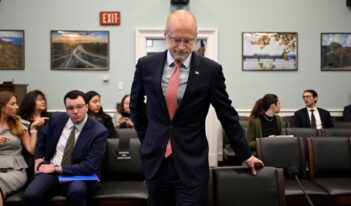
The Supreme Court’s refusal to strengthen protections for veterans will have a lasting impact.
The U.S. Supreme Court’s October 2024 decision in Bufkin v. Collins was a disappointment for veterans’ advocates. The Court’s silence regarding the pro-veteran obligations of the U.S. Department of Veterans Affairs (VA) foreshadows deeper concerns in the evolution of veterans’ law.
Since the Revolutionary War, the U.S. Congress and the American public have had a policy of taking care of the nation’s wounded veterans to encourage voluntary service and retention. The VA is an agency like no other in the U.S. government because the VA system for adjudicating claims for veterans’ benefits is intended to be non-adversarial and pro-veteran, both historically and by statute. The non-adversarial process is so entrenched that federal statute even prohibits veterans from hiring attorneys to help them with filing initial claims.
The Appellant in Bufkin asked the Supreme Court to consider two important aspects of this pro-veteran system: The “benefit of the doubt rule” and the pro-veteran canon. The benefit of the doubt rule requires the VA to resolve any decision in favor of the veteran when the positive and negative evidence are in approximate balance. The pro-veteran canon of statutory interpretation, most famously discussed in the Supreme Court’s 1994 decision in Brown v. Gardner, recognizes Congress intended to treat veterans favorably and held that any ambiguity in a statute is to be resolved to the veteran’s benefit.
Bufkin concerned decisions from the Board of Veterans’ Appeals, which issues the final agency decisions regarding claims for veterans disability benefits, and its determination of the applicability of the benefit of the doubt rule in those cases. The first federal appellate court reviewing VA decisions is the U.S. Court of Appeals for Veterans Claims, a tribunal established under Article I of the U.S. Constitution, known as the Veterans Court. At the creation of the Veterans Court, Congress established the court review the VA’s factual determinations for clear error, requiring a firm belief that an error has been committed by the VA before the court can overturn a Board decision.
For many years, veterans voiced concerns that the Veterans Court’s review under this standard was too deferential. In response, in 2002, Congress added language to the statute requiring the Veterans Court review of VA decisions to “take due account” of the Board’s application of the benefit of the doubt rule.
Claims for veterans benefits often hinge on medical opinions that examine whether a claimed disability was caused by the veteran’s military service. Commonly, veterans will provide a medical opinion explaining why the disability is related to their military service, as it must be for a veteran to receive benefits, and the VA will obtain its own medical opinion, often to the contrary. With one piece of evidence in favor of the veteran’s claim and one piece of evidence against it, the evidence would appear to be in approximate balance, requiring resolution of the claim in favor of the veteran. The Veterans Court in its early decisions explained this doctrine as akin to the sandlot baseball rule “the tie goes to the runner.”
Of course, nothing is that simple. The Board’s determination of what weight is on each side of the scale relies on the Board’s review of each piece of evidence, here medical opinions, and assigning probative value to the evidence. Value is determined by considering, among other things, the reasoning underlying the medical examiner’s conclusions and the breadth of materials the examiner considered. This probative value determination then provides weight that can tip the scale in favor of the VA’s medical opinion and lead to the determination that the evidence is not in approximate balance and the veteran is not entitled to the benefit of the doubt his claim should be granted after all.
In Bufkin, the Board determined that negative VA medical opinions were more probative than an equal number of positive opinions rendering the evidence on the scale leaning towards denying the claim. Therefore, the benefit of the doubt rule did not apply and the Board denied the claim. The Veterans Court reviewed the Board’s decision and its explanations about why the evidence was not in approximate balance, considered VA’s determination to be a factual one reviewed under the deferential clearly erroneous standard, and affirmed the Board’s decision that the benefit of the doubt rule did not apply.
At the Supreme Court, the veteran argued that when Congress told the Veterans Court to “take due account” of the Board’s application of the benefit of the doubt doctrine, Congress intended for the court to do more than review the Board’s decision for clear error. Congress intended that the Veterans Court to review these decisions as legal determinations and therefore not be bound by the Board’s decision. The court should be required to review all of the evidence in the record and replace the decision made by the Board with the court’s own determination as to whether the evidence is in approximate balance. The Government argued that Veterans Court applied the appropriate standard of review and is not permitted under the statute to do the job of the Board by reviewing pieces of evidence to determine why one might be more probative than another.
Justice Clarence Thomas, relying almost entirely on a statutory construction analysis, agreed with the Government that the Veterans Court’s review of these VA decisions are primarily factual and the court is not permitted to substitute its judgment for the Board’s on these issues.
The Supreme Court’s failure to consider the non-adversarial nature of the VA’s adjudication system or the pro-veteran canon of statutory interpretation in this decision is concerning to veterans’ law practitioners for a number of reasons. First, the pro-veteran canon is woven throughout VA decision-making. This case was clearly framed as an issue of statutory interpretation—namely whether Congress wanted a more rigorous analysis by the Veterans Court of VA decision making by adding an admonition to “take due account.” Veteran law practitioners discussed the impact the canon and non-adversarial nature of VA should have in the Court’s consideration of Bufkin in every brief filed, but the Court ignored these historical underpinnings of the system.
Second, Bufkin offered the Court a missed opportunity to resolve how to interpret statutes governing veterans’ benefits in a post-Chevron world. In past decisions, the Supreme Court wrestled with whether to apply Chevron v. National Resources Defense Council, a decision that required courts to defer to reasonable agency interpretations of ambiguous statutes, or Gardner in interpreting ambiguous statutory provisions but did not reach a consensus. Justice Neil Gorsuch has argued that the Court needs to resolve this issue because “those who have served in the Nation’s Armed Forces deserve better from our agencies and courts alike.”
However, the majority never mentioned Gardner or the veteran’s canon in its analysis of the issue and avoided discussing the ambiguity of Congress’ command to “take due account.” Justice Ketanji Brown Jackson’s dissent, joined by Justice Gorsuch, recognized that Gardner requires interpretation of an ambiguous statute in a veteran’s favor and if applied here would potentially require the Veterans Court to do an investigation into the Board’s weighing of evidence instead of what appears to veterans to be the rudimentary review of “clearly erroneous” factual determinations.
This is not the first time Justice Thomas and Justices Jackson and Gorsuch have disagreed on the application of the pro-veteran’s canon. In Rudisill v. McDonough, Justice Jackson authored the majority opinion that found a statute unambiguous but noted that “if the statute were ambiguous, the pro-veteran canon would favor” the veteran. Justice Thomas’s dissent, however, contended that the veteran’s canon should not have a role in our interpretation. It is unsurprising that Justice Thomas avoided discussion of the pro-veteran canon’s impact in Bufkin.
The Court’s failure in its first post-Chevron veteran’s case to even discuss the impact of the canon bodes poorly for a recognition that veterans should be treated favorably in a process intended to preserve the nation’s promise “to care for him who shall have borne the battle.”
If ignoring the pro-veteran canon becomes the norm, Congress and the VA will need to review certain assumptions of the pro-veteran and non-adversarial system, including the assumptions that the VA process will favor veterans and that the influence of attorneys early in the process of seeking benefits is not just unnecessary, but harmful. These decisions will have an impact on all Americans. Our nation should think carefully about our promise to care for those who have been injured in service to our country and the impact that chipping away at pro-veteran policies in the delivery of benefits will have on the voluntary recruiting and retention of armed services members.
This essay is part of a series, titled “The Supreme Court’s 2024-2025 Regulatory Term.”




